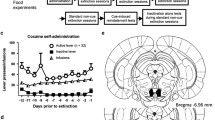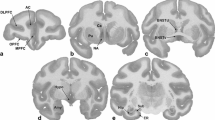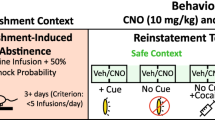Abstract
Rationale
Recent studies have implicated an important role for the dorsal striatum during craving for cocaine and in cocaine-seeking after abstinence in rats.
Objectives
We compared the effects of pharmacological inactivation of mesencephalic dopamine (DA) cell body regions and dorsal vs ventral striatal terminal fields in an animal model of relapse after chronic cocaine self-administration.
Materials and methods
Rats self-administered cocaine for 2 h/day for ten sessions, followed by 2 weeks of abstinence (i.e., no extinction training). Immediately before being returned to the self-administration chamber, we assessed the effects of gamma-aminobutyric acid agonist inhibition of midbrain DA regions (substantia nigra [SN] and ventral tegmental area [VTA]) and striatum (dorsolateral caudate–putamen, nucleus accumbens core, and nucleus accumbens shell) on relapse to cocaine-seeking in the absence of reinforcement. Further testing examined daily extinction responding subsequent to the initial relapse test.
Results
Inactivation of the dorsal caudate–putamen and midbrain regions attenuated cocaine seeking, while inactivation of the ventral striatum had no such effects. However, subsequent sessions under extinction conditions revealed a rebound in cocaine seeking in animals that had undergone inactivation in all regions except the dorsolateral caudate–putamen.
Conclusions
The dorsal but not ventral striatum plays a critical role in cocaine seeking immediately after abstinence. These data support the theory that chronic cocaine may shift activity from the ventral to dorsal striatum during drug seeking under certain conditions. While not necessary at the time of relapse, the ventral striatum appears to be involved in processing critical information of the relapse event.





Similar content being viewed by others
References
Berridge KC, Robinson TE (1998) What is the role of dopamine in reward: hedonic impact, reward learning, or incentive salience. Brain Res Brain Res Rev 28:309–369
Canales JJ (2005) Stimulant-induced adaptations in neostriatal matrix and striosome systems: transiting from instrumental responding to habitual behavior in drug addiction. Neurobiol Learn Mem 83:93–103
Curran EJ, Akil H, Watson SJ (1996) Psychomotor stimulant- and opiate-induced c-fos mRNA expression patterns in the rat forebrain: comparisons between acute drug treatment and a drug challenge in sensitized animals. Neurochem Res 21:1425–1435
Dackis CA, O’Brien CP (2001) Cocaine dependence: a disease of the brain’s reward centers. J Subst Abuse Treat 21:111–117
Epstein DH, Preston KL (2003) The reinstatement model and relapse prevention: a clinical perspective. Psychopharmacology 168:31–41
Everitt BJ, Robbins TW (2005) Neural systems of reinforcement for drug addiction: from actions to habits to compulsion. Nat Neurosci 8:1481–1489
Fallon JH, Moore RY (1978) Catecholamine innervation of the basal forebrain. IV. Topography of the dopamine projection to the basal forebrain and neostriatum. J Comp Neurol 180:545–580
Ferreira TL, Moreira KM, Ikeda DC, Bueno OF, Oliveira MG (2003) Effects of dorsal striatum lesions in tone fear conditioning and contextual fear conditioning. Brain Res 987:17–24
Fuchs RA, See RE (2002) Basolateral amygdala inactivation abolishes conditioned stimulus- and heroin-induced reinstatement of extinguished heroin-seeking behavior in rats. Psychopharmacology 160:425–433
Fuchs RA, Evans KA, Parker MC, See RE (2004a) Differential involvement of the core and shell subregions of the nucleus accumbens in conditioned cue-induced reinstatement of cocaine seeking in rats. Psychopharmacology 176:459–465
Fuchs RA, Evans KA, Parker MP, See RE (2004b) Differential involvement of orbitofrontal cortex subregions in conditioned cue-induced and cocaine-primed reinstatement of cocaine seeking in rats. J Neurosci 24:6600–6610
Fuchs RA, Branham RK, See RE (2006a) Different neural substrates mediate cocaine seeking after abstinence versus extinction training: a critical role for the dorsolateral caudate–putamen. J Neurosci 26:3584–3588
Fuchs RA, Feltenstein MW, See RE (2006b) The role of the basolateral amygdala in stimulus–reward memory and extinction memory consolidation and in subsequent conditioned-cued reinstatement of cocaine seeking. Eur J Neurosci 23:2809–2813
Gerdeman GL, Partridge JG, Lupica CR, Lovinger DM (2003) It could be habit forming: drugs of abuse and striatal synaptic plasticity. Trends Neurosci 26:184–192
Ghitza UE, Fabbricatore AT, Prokopenko V, Pawlak AP, West MO (2003) Persistent cue-evoked activity of accumbens neurons after prolonged abstinence from self-administered cocaine. J Neurosci 23:7239–7245
Graybiel AM, Moratalla R, Robertson HA (1990) Amphetamine and cocaine induce drug-specific activation of the c-fos gene in striosome-matrix compartments and limbic subdivisions of the striatum. Proc Natl Acad Sci USA 87:6912–6916
Haber SN, Kim KS, Mailly P, Calzavara R (2006) Reward-related cortical inputs define a large striatal region in primates that interface with associative cortical connections, providing a substrate for incentive-based learning. J Neurosci 26:8368–8376
Hollander JA, Carelli RM (2005) Abstinence from cocaine self-administration heightens neural encoding of goal-directed behaviors in the accumbens. Neuropsychopharmacology 30:1464–1474
Ito R, Dalley JW, Howes SR, Robbins TW, Everitt BJ (2000) Dissociation in conditioned dopamine release in the nucleus accumbens core and shell in response to cocaine cues and during cocaine-seeking behavior in rats. J Neurosci 20:7489–7495
Ito R, Dalley JW, Robbins TW, Everitt BJ (2002) Dopamine release in the dorsal striatum during cocaine-seeking behavior under the control of a drug-associated cue. J Neurosci 22:6247–6253
Letchworth SR, Nader MA, Smith HR, Friedman DP, Porrino LJ (2001) Progression of changes in dopamine transporter binding site density as a result of cocaine self-administration in rhesus monkeys. J Neurosci 21:2799–2807
Marinelli M, Cooper DC, Baker LK, White FJ (2003) Impulse activity of midbrain dopamine neurons modulates drug-seeking behavior. Psychopharmacology 168:84–98
McFarland K, Kalivas PW (2001) The circuitry mediating cocaine-induced reinstatement of drug-seeking behavior. J Neurosci 21:8655–8663
McFarland K, Davidge SB, Lapish CC, Kalivas PW (2004) Limbic and motor circuitry underlying footshock-induced reinstatement of cocaine-seeking behavior. J Neurosci 24:1551–1560
McLaughlin J, See RE (2003) Selective inactivation of the dorsomedial prefrontal cortex and the basolateral amygdala attenuates conditioned-cued reinstatement of extinguished cocaine-seeking behavior in rats. Psychopharmacology 168:57–65
Nader MA, Daunais JB, Moore T, Nader SH, Moore RJ, Smith HR, Friedman DP, Porrino LJ (2002) Effects of cocaine self-administration on striatal dopamine systems in rhesus monkeys: initial and chronic exposure. Neuropsychopharmacology 27:35–46
O’Brien CP, Childress AR, Ehrman R, Robbins SJ (1998) Conditioning factors in drug abuse: can they explain compulsion. J Psychopharmacol 12:15–22
Paxinos G, Watson D (1986) The rat brain in stereotaxic coordinates. Academic, New York
Pickens R, Thompson T (1968) Cocaine-reinforced behavior in rats: effects of reinforcement magnitude and fixed-ratio size. J Pharmacol Exp Ther 161:122–129
Porrino LJ, Daunais JB, Smith HR, Nader MA (2004a) The expanding effects of cocaine: studies in a nonhuman primate model of cocaine self-administration. Neurosci Biobehav Rev 27:813–820
Porrino LJ, Lyons D, Smith HR, Daunais JB, Nader MA (2004b) Cocaine self-administration produces a progressive involvement of limbic, association, and sensorimotor striatal domains. J Neurosci 24:3554–3562
Robbins SJ, Ehrman RN (1998) Cocaine use is associated with increased craving in outpatient cocaine abusers. Exp Clin Psychopharmacol 6:217–224
Schuster CR, Johanson CE (1981) An analysis of drug-seeking behavior in animals. Neurosci Biobehav Rev 5:315–323
See RE (2005) Neural substrates of cocaine-cue associations that trigger relapse. Eur J Pharmacol 526:140–146
Self DW, Genova LM, Hope BT, Barnhart WJ, Spencer JJ, Nestler EJ (1998) Involvement of cAMP-dependent protein kinase in the nucleus accumbens in cocaine self-administration and relapse of cocaine-seeking behavior. J Neurosci 18:1848–1859
Self DW, Choi KH, Simmons D, Walker JR, Smagula CS (2004) Extinction training regulates neuroadaptive responses to withdrawal from chronic cocaine self-administration. Learn Mem 11:648–657
Shaham Y, Shalev U, Lu L, Wit H, Stewart J (2003) The reinstatement model of drug relapse: history, methodology and major findings. Psychopharmacology 168:3–20
Shalev U, Highfield D, Yap J, Shaham Y (2000) Stress and relapse to drug seeking in rats: studies on the generality of the effect. Psychopharmacology 150:337–346
Stewart J (2000) Pathways to relapse: the neurobiology of drug- and stress-induced relapse to drug-taking. J Psychiatry Neurosci 25:125–136
Sutton MA, Schmidt EF, Choi KH, Schad CA, Whisler K, Simmons D, Karanian DA, Monteggia LM, Neve RL, Self DW (2003) Extinction-induced upregulation in AMPA receptors reduces cocaine-seeking behaviour. Nature 421:70–75
Vanderschuren LJ, Ciano P, Everitt BJ (2005) Involvement of the dorsal striatum in cue-controlled cocaine seeking. J Neurosci 25:8665–8670
Volkow ND, Wang GJ, Fowler JS, Logan J, Gatley SJ, Hitzemann R, Chen AD, Dewey SL, Pappas N (1997) Decreased striatal dopaminergic responsiveness in detoxified cocaine-dependent subjects. Nature 386:830–833
Volkow ND, Wang GJ, Telang F, Fowler JS, Logan J, Childress AR, Jayne M, Ma Y, Wong C (2006) Cocaine cues and dopamine in dorsal striatum: mechanism of craving in cocaine addiction. J Neurosci 26:6583–6588
Wong DF, Kuwabara H, Schretlen DJ, Bonson KR, Zhou Y, Nandi A, Brasic JR, Kimes AS, Maris MA, Kumar A, Contoreggi C, Links J, Ernst M, Rousset O, Zukin S, Grace AA, Lee JS, Rohde C, Jasinski DR, Gjedde A, London ED (2006) Increased occupancy of dopamine receptors in human striatum during cue-elicited cocaine craving. Neuropsychopharmacology 31:2716–2727
Acknowledgments
We thank Ritu Mehta and Alisha Henderson for providing excellent technical assistance. This research was supported by National Institute on Drug Abuse grants DA10462 and DA15369 and NIH grant C06 RR015455.
Author information
Authors and Affiliations
Corresponding author
Additional information
An erratum to this article can be found at http://dx.doi.org/10.1007/s00213-007-0946-1
Rights and permissions
About this article
Cite this article
See, R.E., Elliott, J.C. & Feltenstein, M.W. The role of dorsal vs ventral striatal pathways in cocaine-seeking behavior after prolonged abstinence in rats. Psychopharmacology 194, 321–331 (2007). https://doi.org/10.1007/s00213-007-0850-8
Received:
Accepted:
Published:
Issue Date:
DOI: https://doi.org/10.1007/s00213-007-0850-8




